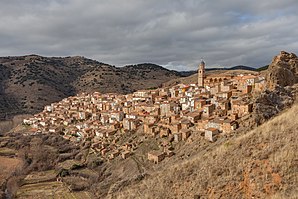Moros (Saragossa)
| Moros municipality | ||
|---|---|---|
 Moros - town view
|
||
| coat of arms | Map of Spain | |
 Help on coat of arms |
|
|
| Basic data | ||
| Autonomous Community : | Aragon | |
| Province : | Zaragoza | |
| Comarca : | Comunidad de Calatayud | |
| Coordinates | 41 ° 24 ′ N , 1 ° 50 ′ W | |
| Height : | 790 msnm | |
| Area : | 53.5 km² | |
| Residents : | 343 (Jan. 1, 2019) | |
| Population density : | 6.41 inhabitants / km² | |
| Postal code : | 50215 | |
| Municipality number ( INE ): | 50178 | |
| administration | ||
| Website : | Moros | |
Moros ("the Moors") is a northern Spanish town and municipality ( municipio ) with 343 inhabitants (as of January 1, 2019) in the west of the province of Saragossa and the autonomous region of Aragon . The place belongs to the poorly populated Serranía Celtibérica .
Location and climate
The village of Moros, located near the border with the old Castilian province of Soria , is located on a 700 to 790 m high hill above the Río Manubles , a tributary of the Río Jalón ; it is located around 40 km (as the crow flies) south of the Sierra de Moncayo, which is at most 2315 m high . The place is about 110 km (driving distance) in a south-westerly direction from the provincial capital of Saragossa ; the historically and culturally significant city of Calatayud is only approx. 24 km to the southeast. The climate is temperate to warm; the rather sparse rain (approx. 390 mm / year) falls spread over the year with the exception of the rather dry summer months.
Population development
| year | 1857 | 1900 | 1950 | 2000 | 2017 |
| Residents | 1,286 | 1,188 | 1,361 | 510 | 364 |
The mechanization of agriculture , the abandonment of small farms and the associated loss of jobs led to a significant decline in the population ( rural exodus ) since the middle of the 20th century .
economy
For centuries, the residents of the village lived directly or indirectly as self-sufficiency from agriculture, which also included livestock farming. The processing of sheep's wool was an important economic factor in the 16th and 17th centuries. Today orchards and viticulture play important roles in the economic life of the place; In addition, holiday apartments (casas rurales) are rented out.
history
Although the place belonged to the settlement area of the Celtiberian Lusones , so far neither Celtiberian nor Roman or Visigoth traces have been discovered. In the 8th century, Arab-Moorish armies penetrated into the upper Ebro Valley, but even from this time there are no archaeologically usable traces for Moros; in the 9th or 10th century a castle (castillo) was built . Around 1120 the area was recaptured by Alfonso I of Aragon ( reconquista ) . The area was long disputed between the kingdoms of Aragón and Castile ( Guerra de los Dos Pedros ) ; this dispute only ended with the marriage of the Catholic Kings Isabella I of Castile and Ferdinand II of Aragón in 1469.
Attractions
- Of the castle (castillo) , which was destroyed in the war against Castile in 1362 , only the remainder of the former 15 m high keep (torre del homenaje) remains .
- The church of Santa Eulalia , built mostly in a mixture of broken stone and brick in the Mudejar style , dates back to the 16th century. Only the two upper floors of the bell tower (campanar) are made entirely of bricks. The nave (nature) is star-curved ; the apse is broken polygonally.
- Surroundings
- In the village and its surroundings are four shrines (peirónes) .
- The Ermita de la Vega is about two kilometers north of the village.
- Only ruins remain of two other hermit churches (Ermita de Santa Bárbara and Ermita de San Miguel) .
Web links
- Moros - photos + short information (spanish)
Individual evidence
- ↑ Cifras oficiales de población resultantes de la revisión del Padrón municipal a 1 de enero . Population statistics from the Instituto Nacional de Estadística (population update).
- ↑ Moros / Calatayud - climate tables
- ↑ Moros - population development
- ↑ Moros - castle ruins
- ^ Moros Church


